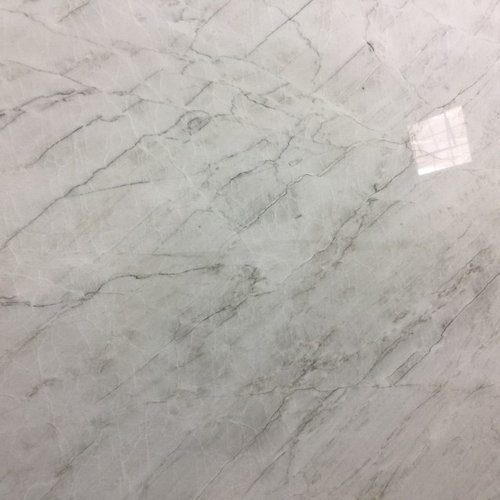Tahiti quartzite

Комментарии: 27
acm
Год(а)/Лет назад: 6Quartzite is softer than granite, a bit harder than marble, and varies a lot. You'd need to run some tests on a sample of your slab. Will probably need some care and handling...
Flo Mangan
Год(а)/Лет назад: 6True quartzite is actually stronger than granite. HOWEVER, NO MATTER WHAT anyone tells you ALL countertops require care to protect them with sealing and hot mats to protect against rapid temperature changes in the stone. And good cleaning products as recommended by supplier. That is beautiful slab just get a copy of the actual invoice the fabricator has that describes the slab product to ensure what it actually is. Look at the side of the slab because quite often that is a clue on whether you are looking at a quartzite or a marble. Marbles have a cloudy/crystal like structure and quartzite is more uniform to my eye. This is visible from the side of the slab. But documentation is the true test.
wilson853
Год(а)/Лет назад: 6beckie, I am also using Tahiti quartzite. It will be installed just before Christmas. What are you using on your perimeter counters? Do you have a white kitchen?
Beth H. :
Год(а)/Лет назад: 6Последние изменения: Год(а)/Лет назад: 6It's also known as a type of White Macaubas, or calacatta quartzite. it also looks like Sea Pearl. your stone place has named it something else.
you can try the etch test on a scrap piece w/lemon juice. (squeeze lemon juice on a spot and wait a 5 mins. wipe off. see how it looks)
you can also take one of your scrap pieces, with a sharp edge, and run the sharp piece across a piece of glass (like a glass tile) if it actually puts a groove in the glass, you prob have quartzite. marble will leave a dust trail and not penetrate.
this is a good article on quartzite
http://usenaturalstone.com/definitive-guide-quartzite/
white macaubas,
sea pearl quartzite, below

D DN
Год(а)/Лет назад: 5I am planning to instal Tahiti Quartzite also. Are you happy with your kitchen island? Do you have any problems with it?
oiqbal81
Год(а)/Лет назад: 5Последние изменения: Год(а)/Лет назад: 5Any chance we can see some photos of finished kitchens with this stone? We're also considering Tahiti Quartzite
D DN
Год(а)/Лет назад: 5I am still searching for a perfect slabs of quartzite. I am thinking about Marquina or Acqua from Terrazzo & Marble, I am not going with Tahiti because I couldn't get a sample of it. I 've found Tahiti at another supplier and I was told that this quartzite is very porous and the fabricator needs extra time to dry it out ( 1-2 weeks) before they can apply sealer. That's why I've changed my mind, otherwise Tahiti is very beautiful.
wilson853
Год(а)/Лет назад: 5I originally planned to use Tahiti quartzite. They were moved to the fabricator and sat outside for a couple of days and absorbed water. The fabricator let us know that the slabs had a problem so they were returned to the wholesaler. It took me several more months to find something that I liked. I ended up with a quartzite called Tahitian Cream from Daltile Stone. It has a similar name but is a completely different quartzite. This stone has been great so far.
Flo Mangan
Год(а)/Лет назад: 5Danuta - what that fabricator is telling you about quartzite makes no sense to me. Quartzite is one of the strongest, densest stones out there. I think I would look around for another provider. Probably sold the slab to someone else. This is why it pays to get educated on these stone choices in advance. Then when you do find something, you take photos of the slab and the side of the slab where each slab has a unique bundle # and slab # noted on the side edge. This identifies it specifically and will save you a ton of trouble if you keep good documentation as you hunt for products. Keep a spiral note book, noting date, name of slab, the numbers I just mentioned, and get them to pull the slab and take a photo, preferably with the stone rep standing with it. Granite and quartzite are readily available and have been reducing in price to compete with "quartz" which is a man-made product. Varying amounts of resin to crushed granite or other stone materials. It is manufactured not "naturally" occurring stone.
Irene Morresey
Год(а)/Лет назад: 5The first and most important difference is that materials that are referred to as “Quartz” are man-made, engineered stones made of natural quartz and resin in a factory. Quartzite is a 100% natural stone that is dug up out the earth, polished and cut into slabs. They both are made mostly of quartz, one of the hardest substances on earth, which make them ideal for kitchens and high use areas. Because of this natural hardness, both resist staining and etching from acidic liquids. A subtle difference between Quartzite and Quartz is that Natural quartzite can be polished to a high gloss. Engineered quartz often cannot achieve that level of sheen. There is a small subset of material known as “Soft Quartzite” which performs more like a marble. Be sure to ask your salesperson about the specific varieties you’re considering
Engineered Quartz slabwilson853
Год(а)/Лет назад: 5Flo, quartzite is very hard, but that doesn't make it non-porous. There are many threads on here which show installed quartzite (especially some of the whiter quartzites like macaubus) with dark staining, especially on cut edges. My suggestion is to make sure that your fabricator seals the inside of all drilled holes and any cut edges. In my case the fabricator went to the wholesaler with me and we picked the slabs that we liked best from the bundle of Tahiti quartzite that I had chosen. Once they sat outside over a rainy weekend at the fabricators they absorbed water. The fabricator did further research about this stone and spoke to the wholesaler who took the slabs back with no restocking charge.
wilson853
Год(а)/Лет назад: 5I would also like to add that I tested these slabs at the wholesaler with lemon juice and there was no etching.
wilson853
Год(а)/Лет назад: 5This is an important read for anyone considering quartzite written by a frequent advisor on these forums.
Jean Kappes
Год(а)/Лет назад: 5I am thinking of Tahiti Quartzite also - good article to read. would help to see pictures of kitchen
mrhone
Год(а)/Лет назад: 4Can anyone who has installed Tahiti quartizite give photos and/or comment on durability, etching, staining etc?
ServiceMaster of North Texas
Год(а)/Лет назад: 3Those that have Tahiti quartzite, any updates on how they have performed?
J5 Remodeling & Design
Год(а)/Лет назад: 3I would love to see a finished bathroom or kitchen. Is there a paint color that you recommend to compliment this stone?
angelamcf
Год(а)/Лет назад: 3I have had Super White Quartzite for 5 years in my kitchen. It’s absolutely beautiful, however it’s not indestructible. I have chips above the trashcan and on the backsplash ledge. I do see some scratches where we put our plates on the counter. I have marble in the bathrooms and I must say that quartzite is much easier to care for than marble.

kdwyer82
в прошлом годуI installed Tahiti quartzite about 2 yrs ago. I am replacing it with Taj Mahal. Below are photos of the problems that I experienced within 7 mos. of installation. It was beautiful when installed, then turned gray around all the cut edges and in some field areas. We tried acetone, followed by drying for several weeks, and using a heat gun. Also tried a poultice of baking soda and acetone. All failed, though some edges did improve, but did not resolve even when it was repeated.



Beth H. :
в прошлом годуПоследние изменения: в прошлом годуkdwyer82 that's the water/resin/epoxy (either from mesh backing, or whatever they used to adhere it to the countertop) You can see the perfect line of it along the seam in the second picture.
(or, according to some, it's the soaking and absorption of water. see the italic paragrah below for explanation)
What did the fabricator say about it? You need to show him these articles. I hope he is reimbursing you. This is on them that they don't take the time to properly coat these edges w/resin.
same issue here. scroll down a bit and read the comment written by granite guru:https://www.houzz.com/discussions/5485633/quartzite-advice-the-counter-is-staining
This link is also informative on staining of quartzitehttps://stein.akemi.de/fileadmin/user_upload/beitraege/Flecken_auf_hellem_Quarzit_-_was_tun_EN.pdf
Moisture gets into the countertops through various cutting and drilling processes (e. g. water jet cutting). Normally, thanks to their porous structures, natural stones dry by allowing the penetrated moisture to rise vertically and horizontally to the stone surface and then to evaporate. Only when the stones are absolutely dry, a subsequent protective treatment can be started. However, quartzites behave differently. Due to their very dense, finely developed pore system in the stone layers, moisture often only penetrates via the cut edges, resulting in a visible darkening of the edge surfaces . The absorbed water can hardly rise up vertically to the stone surface due to the strong capillary forces caused by the fine pores. Basically, the smaller the pore size, the more pronounced the capillary force is. In addition, many quartzites are resin coated on the surface already on the factory, which complicates the process described above even more. The moisture can therefore only leave the stone very slowly in the direction of the cut edge. As a result, quartzites require a comparatively higher drying effort (e. g. through active drying in drying ovens or hot air drying), which can also last longer (several days or even weeks). Wiping cloths soaked in detergent and dissolved cooking oils (kitchen) / cosmetic oils (bathroom) are often used to clean the surfaces and edges. While the surfaces of quartzites are usually resin-coated and thus almost impermeable to water, moisture and dissolved fat components can penetrate the stone at the untreated edges. With each cleaning process, small amounts of a water/oil/surfactant mixture penetrate into the stone and accumulate there.
did you ever test it? since you're replacing it, test it now
Use a sharp edge or point of the stone to scratch the surface of the glass using high force. One of two things will happen, either the glass will scratch because the stone is harder or the stone will crumble because the glass is harder. If the glass scratches, you have quartzite. If the stone crumbles, you have marble.
Joseph Troskie Design
в прошлом годуThis is interesting. Haven't tried it yet.
https://pellegrinostonecare.com/wp-content/uploads/2021/06/Quartzite-Stain-Removal-Guide-PSC.pdfjenb_ontario_6b
Месяцев назад: 6In case this thread comes up for future buyers, I wanted to add my experience with Tahiti quartzite. We purchased the slabs through our fabricator and they were in the process of mapping the layout when one of the slabs absorbed water. We agreed to wait a few days to see how the water would dry out. After 3 days, faint water spots remained and so we decided not to go with Tahiti. The two employees there said they’ve never seen anything like that in the 2-3 years they’ve been working there, not even with marble. We couldn’t risk having the slabs cut then seeing how they dry out, especially considering the cost of the slabs and fabrication. luckily, the stone supplier agreed to issue a refund. We’re super disappointed because Tahiti is truly one of a kind. some comments here saying that quartzite is not like this, well this is considered a very porous quartzite and we witnessed the progression of the water stains ourselves and i would avoid wasting time and disappointment! We’re shopping again but adding that the other stones i loved but hubs wasnt a big fan were Everest and Brasille quartzites.
justhighstone
Месяцев назад: 6Tahiti Quartzite is a beautiful natural stone that is often used for countertops and kitchen islands. However, like most natural stones, its performance can vary based on the specific slab and its unique characteristics. Here are some general considerations for Tahiti Quartzite in terms of etching, staining, and watermarks:
- Etching: Etching can occur on natural stone surfaces, including quartzite, when they come into contact with acidic substances such as lemon juice, vinegar, or certain cleaning products. The extent to which Tahiti Quartzite etches can depend on its specific mineral composition and the severity of exposure. To minimize etching, it's advisable to clean up spills promptly and avoid using acidic substances on the surface.
- Staining: Quartzite is less porous than some other natural stones like marble and granite, but it is not completely stain-resistant. Stains can occur if liquids like red wine, coffee, or oil are left to sit on the surface. To prevent staining, it's essential to wipe up spills promptly and regularly seal the surface with a quality stone sealer to enhance its resistance to stains.
- Water Marks: Watermarks can sometimes appear on natural stone surfaces, including quartzite, especially in areas with hard water. These marks are not necessarily permanent and can often be removed by cleaning the surface with a stone-safe cleaner and a soft cloth. Regular cleaning and proper maintenance can help prevent watermarks.
Since the performance of natural stone can vary from one slab to another, it's a good idea to consult with your stone supplier or installer for specific care and maintenance recommendations tailored to your Tahiti Quartzite slab. They can provide guidance on sealing, cleaning, and protecting the stone to keep it looking beautiful over time.
In addition, if you have any concerns about the performance of Tahiti Quartzite in your kitchen, you might consider performing a simple water and oil absorption test on a small, inconspicuous area of the stone to assess its porosity and make informed decisions regarding its care.





Econ Granite